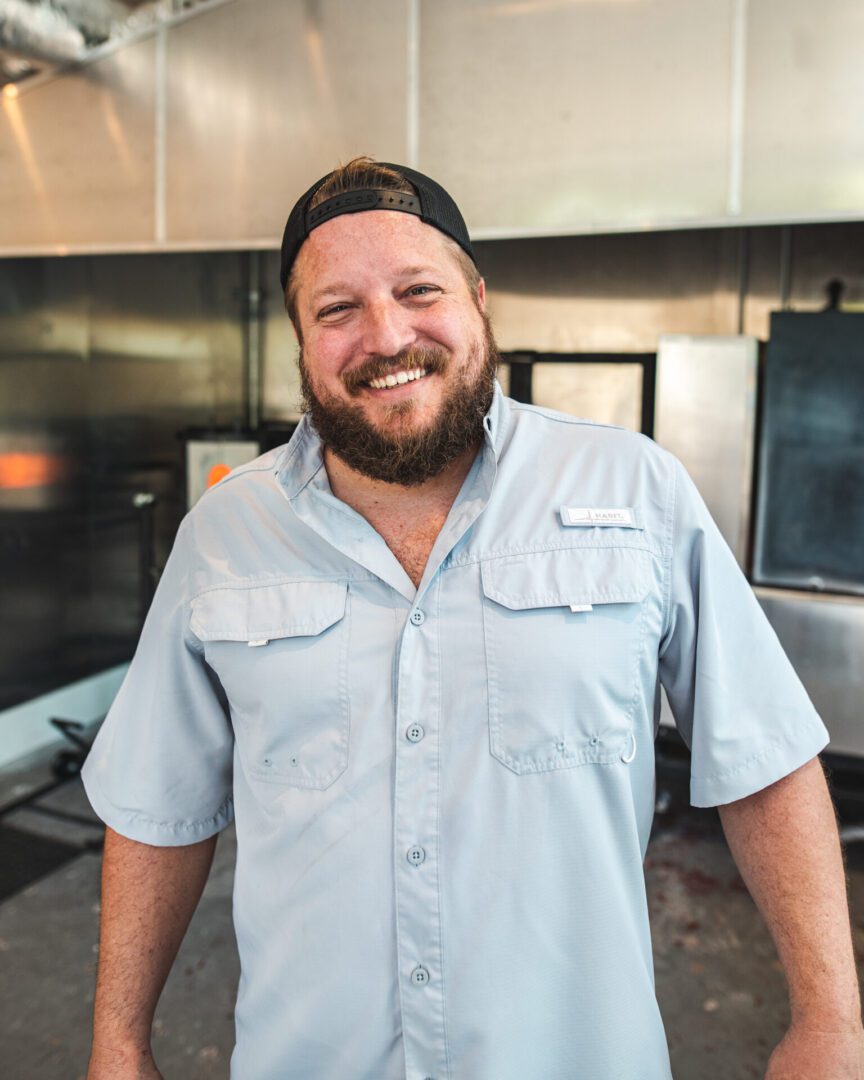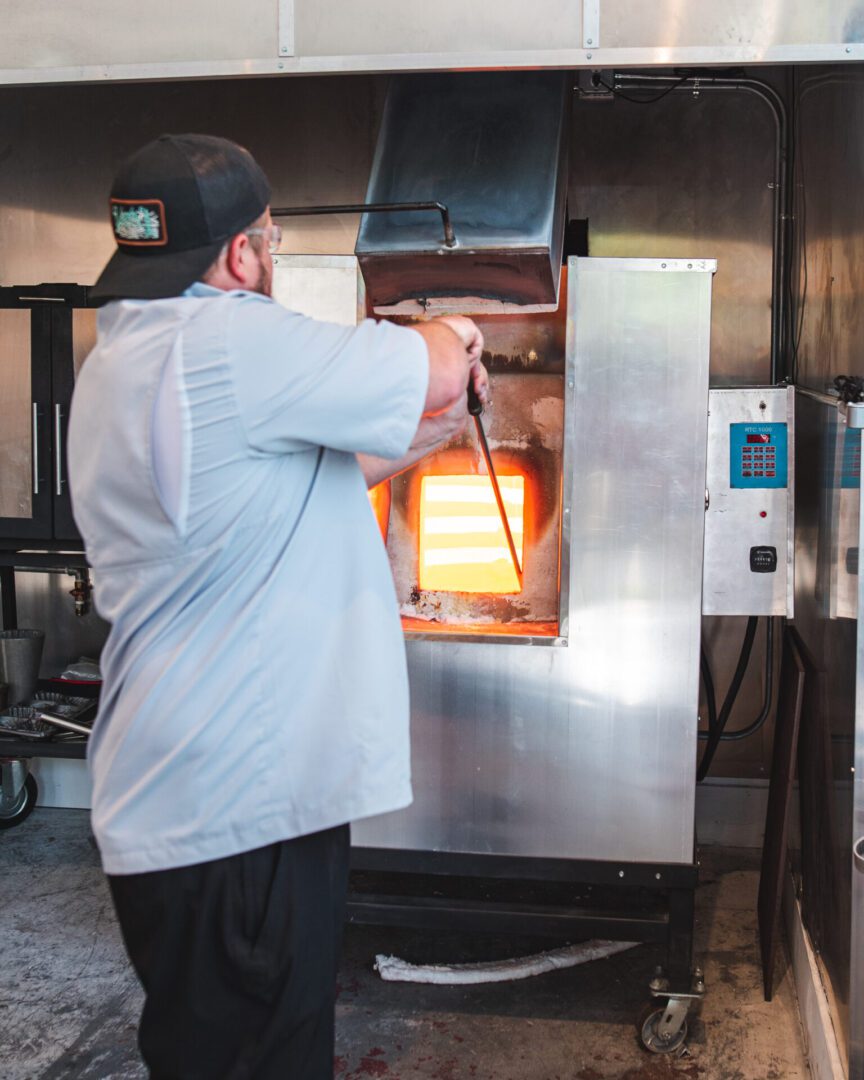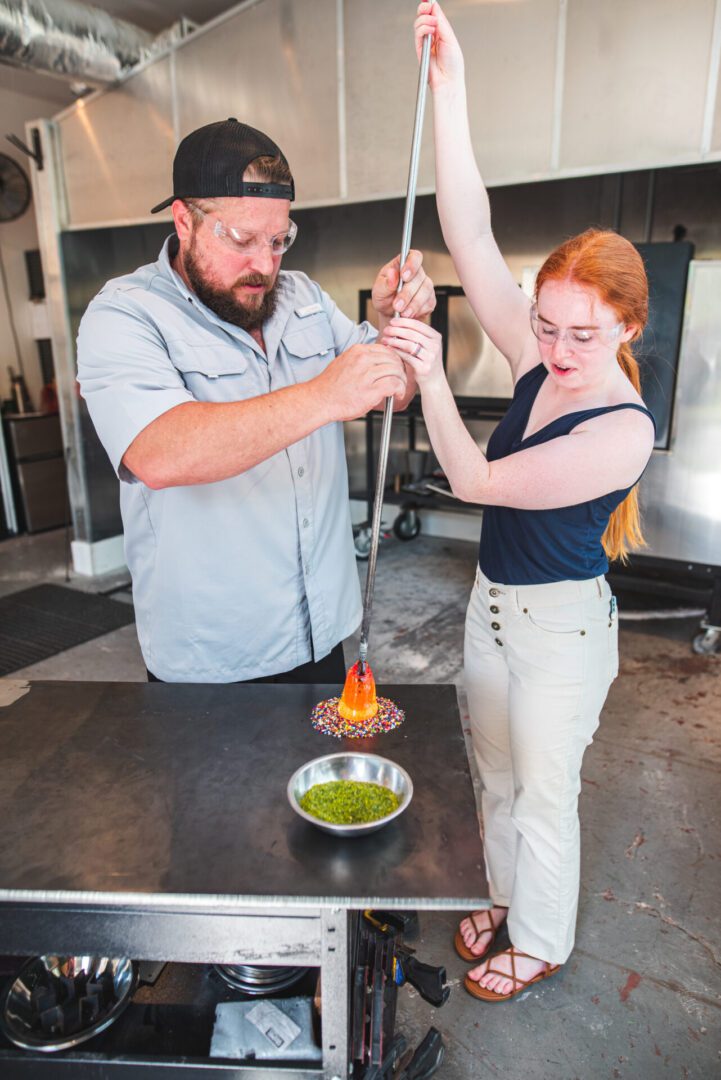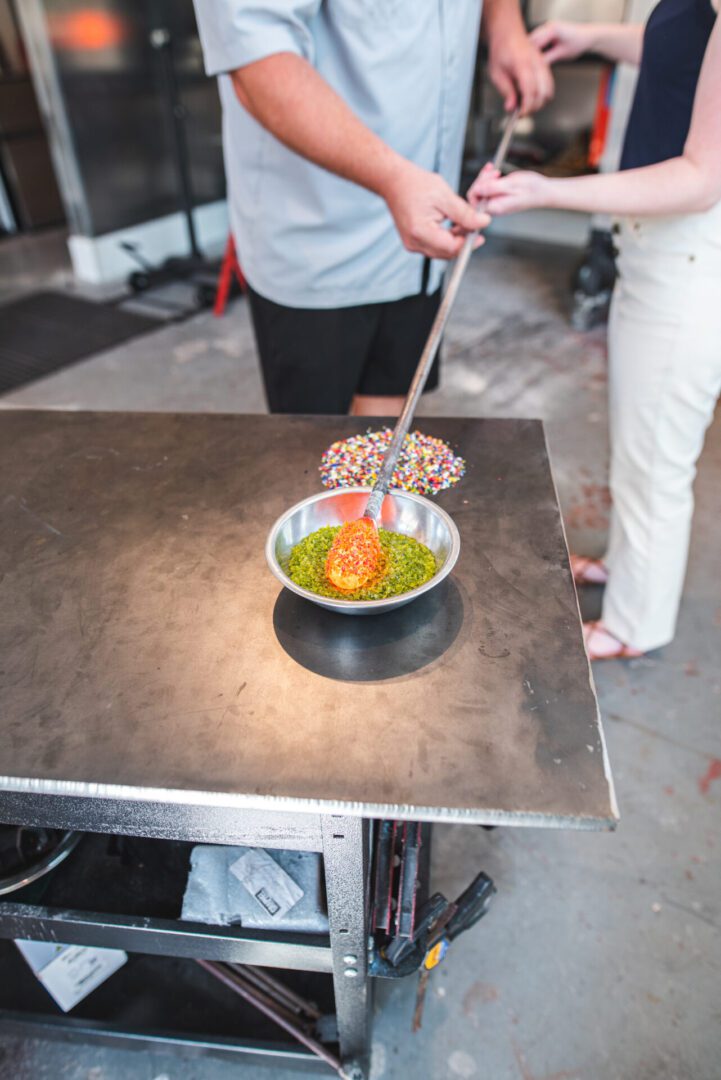What if you could step back in time? What if you could walk into a studio and suddenly you’re no longer in the twenty-first century, but instead you’ve found yourself transported thousands of years into the past. You see a substance that resembles molten lava being handled with skill and precision. You see colors and glass and fire morphing together to form shapes that you didn’t know were possible for any of them to make. This is the environment that glassblowing artist and owner of Blown Studios, Brandon Price, has cultivated. We were able to speak with Price both regarding his journey as a glassblowing artist and his work creating Blown Studios and bringing glassblowing to a new community.

Tomorrow’s World Today (TWT): How did you get started with glassblowing?
Brandon Price (BP): I was first introduced to glassblowing while attending college at Bowling Green State University in Ohio. I was 21 years old and had just returned to Ohio from a short stint in Los Angeles where I had moved to pursue an acting career. I quickly realized that was not the life for me and returned to Ohio in search of a new direction. I was on the Bowling Green campus walking through different buildings, contemplating my next move when I somehow found myself in the art building. I looked through a little window and saw something totally unexpected – they were playing with molten lava! There were blow torches firing and music playing people dancing and sweat flying – it was unlike any other classroom I’d ever seen. I was mesmerized. Needless to say, I was instantly hooked and I knew right then that I was going to be a glassblower.
I didn’t waste a minute. I walked into the classroom and asked who I needed to talk to in order to join the class. I was ready to get started that day, that minute. Robert “Bud” Hurlstone was the man in charge. He asked if I was an art major? “No.” Have you taken any prerequisites for this class? “No.” “Then ‘No’ you can’t take this class.” I was not taking that for an answer and seeing I was still intent on learning he agreed to let me observe him blow glass on Friday and Saturday nights from 8:00 p.m. to 1:00 a.m. That time served as my apprenticeship, and I was able to prove to him how dedicated I was to learning the art. For around six months I went each weekend, never missing a day. On one particular day, “Bud” went to heat the glass but couldn’t open a door with his hands full. This was my chance and I seized the opportunity! In anticipation of his next move, and without even really thinking, I instinctually jumped up and opened the door to the reheat furnace for him. He then said the words I had been waiting to hear “I’ll see you in class on Tuesday, but don’t bother me on the weekends anymore.” I told him he had a deal!
TWT: How would you describe yourself as a glassblowing artist? How would you describe your work?
BP: I would describe myself as an artist-educator. I create my own work and also teach others about glass blowing through the workshops I offer at the studio. I make functional work such as glassware, wine decanters, jewelry, bowls, platters, chandeliers, and items people can use on a daily basis in their lives and homes. When creating those pieces, I am inspired by the design and actual functionality of the item – how it will be used.
I’m also often inspired by colors, I’ve always had a fondness for [working with] different glass colors because of how they react to each other when combined with different metal oxides. It is like a science experiment. I don’t know what the outcome will be even after years of tinkering with them. Sometimes, a piece begins with a color or several colors that I would like to see used together and develops organically from there.
I also enjoy sculpting glass and a majority of my sculptural work is inspired by sea life. I recently began making seashells and that has become a new fascination of mine. I like sculpting sea life because the forms lend themselves to the glass process, they’re both very fluid which makes the process feel natural.
One of the main focuses of my current location Blown Studios Savannah is to teach and educate the public about the glassblowing process. I offer workshops to provide an opportunity for people to learn about the process whether they are a novice glassblower or more experienced and looking to advance their skills.
TWT: Was there ever a specific instance that inspired one of your pieces directly?
BP: When I turned 30, one of my goals was to take a trip to work with a group of artists in Hawaii. I worked and saved enough to take the trip and spent 10 days working near Ho’okipa. I was fortunate enough to learn from some amazing artists during my time there. One afternoon, in an attempt to cool down, I decided to try my hand at surfing. I was out in the water and when I put my head under the waves, I could hear whales. It was incredible. As I came up out of the water, I could see the humpback whales breaching [the water]. When I got back to the studio that day, I sat down and began figuring out how to design and sculpt a humpback whale. So, though my surfing career didn’t take off quite like my glassblowing career, it was a great experience because it led me to create something out of glass that was inspired by my experience in nature. That is really when I discovered my love for creating sea life out of glass.

TWT: How has your work changed over time/how have you grown with your glassblowing techniques?
BP: It’s a constant learning process. I am always looking to evolve, expand, and improve my skills as an artist. I’ve progressed and practiced certain techniques as I continue to challenge myself to discover the wonders of glass. I study with and research others in the industry to constantly reminded me how many different techniques are out there. There is always a new method–a new way of creating–to learn and experiment with. Or I may see an object or an animal and feel compelled to find a way I can recreate that using glass. My first teacher always said, “There’s nothing new in glassblowing, you’re just trying to reinvent the wheel.” Though this may be true, you’re always trying to come up with a better, more efficient way to do something, trying to discover ways to refine the existing processes and make them “your own” by putting your own stamp, your own perspective on it. After 22 years in the industry, I am still constantly learning, working on my process, and trying to get better every day. Teaching others and hearing and responding to their thoughts and questions helps greatly with this. Seeing their interest inspires me to learn and continue creating.
TWT: You previously worked as Disney’s glassblower on Main Street for five years. How would you describe your experience? Any particularly inspiring or rewarding moments that stood out to you?
BP: This may sound a bit cheesy, but honestly, every day was special. That is what they strive to do at Disney, create those magical moments. I really enjoyed that experience and my time working there. I had several couples come in who were either recently engaged or getting ready to propose and ask to have glass slippers made or some kind of keepsake. It felt good to be a small part of such an awesome and significant moment in their lives. It’s a good feeling knowing they will cherish that item that you made forever. It will always be special to them.
Seeing younger children come in was always very entertaining. To watch their eyes light up as they witnessed glassblowing for the first time was and still is a great feeling.
There was one couple in particular who came in to watch my demonstrations frequently. They began to ask more and more questions with each visit and we became friends. I was able to help them find a school where they could learn how to blow glass. Now they’re actually working in the industry as glass artists. Being able to help facilitate that was definitely rewarding.
TWT: What inspired you to start Blown Studios?
BP: I have worked in other studios and helped open studios around the country and through those experiences, I began to develop my vision for Blown Studios. I wanted to create an intimate space where I could teach people and also have the freedom to focus on and create my own work. I relocated to Savannah, GA almost four years ago and instantly knew it was the perfect location for Blown Studios. Savannah has a strong and growing art scene but I saw it as the perfect opportunity to bring glassblowing to Savannah and the surrounding communities. It was a natural fit.

TWT: What has been your biggest challenge as a glassblowing artist and/or business owner? How did you overcome it?
BP: The first challenge that comes to mind is the cost. The equipment and tools involved are very expensive and specialized. If something breaks or malfunctions, it can be difficult and costly to repair. Opening Blown Studios has been a long-time dream of mine and I was persistent and determined to make it a reality.
I met and worked with the SBA (Small Business Administration), the Small Business Development Center, and networked and connected with as many people as possible to gain support and guidance from members of the community. I am very grateful to all of those who have helped and encouraged me along the way!
Another challenge is the sheer heat from the equipment. The furnace is about 2,100 degrees. If you’ve ever visited Savannah in the summertime, I am sure you can imagine, it gets hot in here! But I promise enduring the heat is well worth the experience. I would recommend packing yourself a traveler! And we have fans, LOTS of fans!
TWT: What is the most rewarding part of your glassblowing workshops?
BP: The satisfaction of sharing and teaching others about glassblowing. Whether they’ve seen it on TV, watched a YouTube video, or maybe they’ve visited one of those recreation villages like Jamestown or Williamsburg, they are excited about learning how to blow glass. I get to provide them with that opportunity and that’s incredibly rewarding. I also get to meet and make connections with interesting people from all over the world.
TWT: What’s the most difficult part of glassblowing for beginners? How do you help them overcome the challenge?
BP: Definitely the heat as I mentioned a bit earlier. When you’re working with glass, it’s the same temperature as molten lava. You’re working at around 2,100 degrees. I provide them with protective gear such as kevlar sleeves and gloves, so they can’t feel the heat as intensely. I think sometimes the heat and the noise can create a bit of fear. Before every workshop, I discuss safety with them and the dos and don’ts of working with hot glass. We talk through how the workshop will run and I let them know I will be there, working closely with them throughout each step of the process to ensure their safety. Once the conversation starts and the music is playing, the excitement takes over and the heat doesn’t feel as intense. The fears tend to slip away. I really try to make sure every person is as comfortable as possible and feels safe. We have lots of water on hand, again LOTS of fans, and pickle juice (which helps keep you hydrated!).

TWT: What are your goals for the future?
BP: Eventually, I’d like to build an educational facility that allows me to reach more people and larger groups at a time. My goal is to continue to teach others about the beauty and art of glassblowing and keep people interested in it.
As for my own personal work, I would like to begin creating more architectural pieces such as large-scale castings and working with bricks, stair treads, actual elements that have been made a certain way for thousands of years, and incorporating glass into them to create a new effect.
TWT: Who are your role models and why?
BP: Definitely my first teacher, Robert ‘Bud’ Hurlstone. My family for their constant support throughout this process. Glassblowing is not the most conventional path so their support has helped me keep me going when things were difficult. As for glassblowers, William Morris, who is one of the greatest glass sculptors of my generation. He has definitely been a big inspiration for me. Also, Dale Chihuly, who is an incredible glass marketer. What he has done for the community has been instrumental in introducing glasswork into the public eye and helping develop the industry.
TWT: Do you have a favorite piece you’ve ever made? If so, why was it your favorite?
BP: One of my favorite pieces is definitely Charlie the Turtle, it’s a full-size sea turtle. I worked with a glass sculptor named Charles Lowrie, who passed the process and techniques needed to create a piece like this on to me. The fact that I was able to make that piece was very special to me. It was such an accomplishment and stands out to me as a mile marker and growth as an artist. It took a team of six people collaborating for several hours to bring Charlie to life. The sculpture is on display in the studio for people to see when they come in. It is a nice reminder and a great conversation starter.
TWT: What piece of advice would you give to people who want to try glassblowing?
BP: If you’re in or near Savannah, definitely reach out to me, I’d love the opportunity to work with you. If you are not in the Savannah area, I would recommend researching glassblowers in or close to your area. I would call the studios in your area and ask if you can come in to watch a demonstration or if they conduct workshops that you can participate in.
TWT: What piece of advice would you give to other glassblowing artists who are similarly working to bring the art form to their communities?
BP: Don’t stop. It’s ironic because that’s the same advice I give to people when they’ve just started blowing glass, “Don’t stop spinning.” If you stop spinning the glass, it will just fall off the end. The same thing goes for someone who is trying to open or maintain a studio, don’t stop spinning. You just have to keep it going.
TWT: What is the biggest change you’ve seen in the industry since you’ve started? What changes do you see happening in the future?
BP: Recently, for the first time, we have experienced glass shortages. The manufacturing process has become so expensive to run in the United States that there was a point where artists were scared that we weren’t going to be able to get the necessary raw materials anymore. It got to the point that people were buying full containers of cullet and storing as much as they could. It doesn’t go bad but if you can’t get it, you can’t melt it. Things seem ok for the moment (fingers crossed).
The industry is also experiencing trouble maintaining a stock of colored glass. The manufacturers producing the color are having a hard time keeping their doors open. Some of that is due to COVID, some of it because of environmental regulations on the use of different heavy metals that they use during the production of these colors. One of the largest equipment manufacturers in the United States just shut its doors a few weeks ago. I hope the community rallies around the people that are still creating the supplies and equipment we need to function and keep the art of glass blowing alive.
I also hope we can find a way to positively impact the environment by using recycled glass. Glass is a 100% recyclable material so finding ways to use and implement recycled materials into the artistic field so that we have less of carbon footprint would be hugely beneficial.
For more information about Brandon and Blown Studios, visit blownstudios.com or follow them on Instagram @blownstudios.
Learn more about the World of Creation, and discover the art of scientific glassblowing, the history of pottery, and how recycled art turns trash into treasure.
To discover more about glassblowing’s role in sustainability, stream Tomorrow’s World Today’s “Sustainable Hotels” on YouTube!







